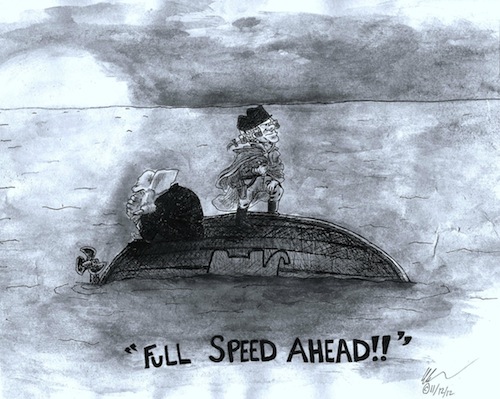It's been a bad couple weeks for Mitch McConnell. To start off, last week it was announced that the Senate Minority Leader will face a primary challenge from the Tea Party, and this week we've learned his Democratic opponent is leading him in the polls -- though that was to be expected early on. However, Mitch isn't the only Republican feeling the heat. Senator Lindsey Graham will also face a rising Tea Party star.
There is a growing division within the GOP between the establishment and the Tea Party that I have written about before. This split is a part of a greater political process taking place in the U.S..
Professor emeritus of political science at the University of Texas at Austin, Walter Dean Burnham believes realignment cycles happen roughly every 30 years in the U.S. According to this theory, there are four phases of this process:
Phase #1: constituencies are coalescing around certain critical issues; tensions arise in society because these mobilizations are not adequately organized or controlled by the outputs of party politics as usual (these tensions are associated with abnormal stress in the socioeconomic system). Phase #2: a "third party revolt" demonstrates the incapacity of regular parties to integrate these issues within their platforms (which would otherwise appease their constituencies and dampen tensions); ideological polarization occurs among and within parties. Phase #3: flashpoint; parties adjust to resolve the tension Phase #4: significant transformation in policy; post-adjustment, institutional elites change behavior.
Burnham has identified six party systems that have existed in the U.S. The last of these great shifts began with the GOP capture of the South. However, I believe 2012 was the start of a seventh system.
Prior to the election, the Occupy movement brought the issues of inequality and the influence of money in politics, to the forefront of the national dialogue. These protesters did not specifically join either party. The Democrats welcomed Occupy as a potential voting block, while the Republican response was to call them envious and push for a platform of the same policies they were protesting. This refusal to change course cost the GOP dearly in November, when it lost voter majorities in all three national races. Now we are seeing the effects slowly seep into law with initiatives like the Consumer Financial Protection Bureau.

Since the defeat, the Republicans have been trying to figure out how to proceed. The trouble is, they cannot go in the direction they need to go because of the Tea Party. This is causing a divide, as well as a complete shutdown in government. The Tea Party House refuses to compromise with the president and his party (for reasons I have also written about), while Senate Republicans recognize the need to do just that. The GOP faces the problem of having to cater to the fringe of their base at a time when the rest of the country is running away from them. This is why I think it is unlikely the party will make a significant showing in the 2014 or 2016 elections.
This statement puts me at odds with possibly the best political statistician in the business. In February, FiveThirtyEight's Nate Silver asserted that the GOP was poised to take the Senate due to the likelihood that Republicans would pick up four seats. It made sense given that the Democrats have more to lose this election. Then in July he said that the GOP would likely take the Senate in 2016. But I disagree with Mr. Silver (a dangerous position to stake).
Silver's predictions came out before either Lindsey Graham or Mitch McConnell faced any significant challenge. If either one of these two senators lose, Silver's prediction is thrown off. But is there a risk of that happening?
Silver's own work indicates that both McConnell's and Graham's states are safe Republican and likely Republican, respectively. This fact might work against the GOP. According to The Daily Beast, the extreme conservatives like the Tea Party, are the most likely to vote in elections, including primaries. What's more, 54 percent of Republicans believe their party isn't conservative enough, and 35 percent say their party leaders have been too compromising in their dealings with President Obama. There is a very real chance that the Republican voters in Kentucky and South Carolina will vote for the Tea Party challengers because they view their senators as too moderate -- and that is problematic.
At the height of its power, the Tea Party only boasted the support of 31 percent of the American people, according to a CBS poll from 2010. Even then, its electoral success was limited to the House where it boasted 87 freshmen, as opposed to only three in the Senate. There's a good reason for this discrepancy: districts. Senators represent the entire state while representatives only represent a specific district. There is no gerrymandering in the Senate and the Tea Party lacks the broad appeal needed to make a significant showing.
Nevertheless, incumbents do have a number of advantages in politics. The most obvious of these is financial. According to OpenSecrets.org incumbents outspend their challengers roughly 8 times over, on average. However, monetary superiority is a mere means to an end. The largest benefit to being an established politician is name recognition. People are psychologically more motivated to vote for names they recognize. For this reason, challengers must spend huge amounts of money just to get their name out there -- and even then, they rarely win the spending war.
So, now let's assume McConnell and Graham keep their seats against their Tea Party opponents. This may still not be enough to make up for the loss of enthusiasm on the right.
The Tea Party is a significant voting block for the GOP, as I mentioned above. Nowhere is this more apparent than the 2010 election; the astroturf movement was what breathed new life into a GOP crippled by 30 years of failed Republican economic policy and of course, the disastrous Bush presidency. However, as Naples News reports, many of America's tricorn-hat-wearing activists plan on sitting out the 2014 election as protest of the more moderate positions taken up by many Republicans. Voter decline is a major problem for a party that was just electorally beaten in the most heated election since Lincoln.
It remains to be seen what will happen, but no matter what, the GOP isn't out of the woods. McConnell and Graham were both sure wins, according to Nate Silver, but now they are less certain. Even if Silver's prediction comes true, the writing is on the wall. The Republicans will not be able to sustain their far right positions, and thus will not be able to keep the Tea Party. When the divide completes, the Democratic policies will dominate for 30 years. So let me reiterate my prediction: The Republican Party is dead for the time being.
